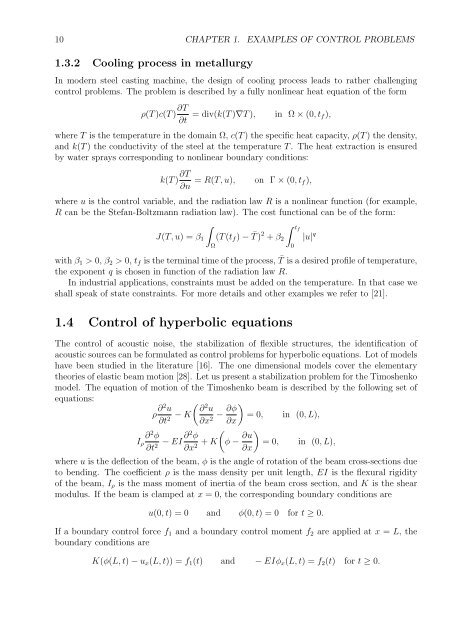Optimal Control of Partial Differential Equations
Optimal Control of Partial Differential Equations
Optimal Control of Partial Differential Equations
You also want an ePaper? Increase the reach of your titles
YUMPU automatically turns print PDFs into web optimized ePapers that Google loves.
10 CHAPTER 1. EXAMPLES OF CONTROL PROBLEMS<br />
1.3.2 Cooling process in metallurgy<br />
In modern steel casting machine, the design <strong>of</strong> cooling process leads to rather challenging<br />
control problems. The problem is described by a fully nonlinear heat equation <strong>of</strong> the form<br />
ρ(T )c(T ) ∂T<br />
∂t<br />
= div(k(T )∇T ), in Ω × (0, tf),<br />
where T is the temperature in the domain Ω, c(T ) the specific heat capacity, ρ(T ) the density,<br />
and k(T ) the conductivity <strong>of</strong> the steel at the temperature T . The heat extraction is ensured<br />
by water sprays corresponding to nonlinear boundary conditions:<br />
k(T ) ∂T<br />
∂n<br />
= R(T, u), on Γ × (0, tf),<br />
where u is the control variable, and the radiation law R is a nonlinear function (for example,<br />
R can be the Stefan-Boltzmann radiation law). The cost functional can be <strong>of</strong> the form:<br />
<br />
J(T, u) = β1 (T (tf) − ¯ T ) 2 tf<br />
+ β2 |u| q<br />
Ω<br />
with β1 > 0, β2 > 0, tf is the terminal time <strong>of</strong> the process, ¯ T is a desired pr<strong>of</strong>ile <strong>of</strong> temperature,<br />
the exponent q is chosen in function <strong>of</strong> the radiation law R.<br />
In industrial applications, constraints must be added on the temperature. In that case we<br />
shall speak <strong>of</strong> state constraints. For more details and other examples we refer to [21].<br />
1.4 <strong>Control</strong> <strong>of</strong> hyperbolic equations<br />
The control <strong>of</strong> acoustic noise, the stabilization <strong>of</strong> flexible structures, the identification <strong>of</strong><br />
acoustic sources can be formulated as control problems for hyperbolic equations. Lot <strong>of</strong> models<br />
have been studied in the literature [16]. The one dimensional models cover the elementary<br />
theories <strong>of</strong> elastic beam motion [28]. Let us present a stabilization problem for the Timoshenko<br />
model. The equation <strong>of</strong> motion <strong>of</strong> the Timoshenko beam is described by the following set <strong>of</strong><br />
equations:<br />
ρ ∂2 2 u ∂ u ∂φ<br />
− K −<br />
∂t2 ∂x2 ∂x<br />
∂<br />
Iρ<br />
2φ ∂t2 − EI ∂2φ ∂x<br />
2 + K<br />
<br />
φ − ∂u<br />
∂x<br />
<br />
= 0, in (0, L),<br />
0<br />
<br />
= 0, in (0, L),<br />
where u is the deflection <strong>of</strong> the beam, φ is the angle <strong>of</strong> rotation <strong>of</strong> the beam cross-sections due<br />
to bending. The coefficient ρ is the mass density per unit length, EI is the flexural rigidity<br />
<strong>of</strong> the beam, Iρ is the mass moment <strong>of</strong> inertia <strong>of</strong> the beam cross section, and K is the shear<br />
modulus. If the beam is clamped at x = 0, the corresponding boundary conditions are<br />
u(0, t) = 0 and φ(0, t) = 0 for t ≥ 0.<br />
If a boundary control force f1 and a boundary control moment f2 are applied at x = L, the<br />
boundary conditions are<br />
K(φ(L, t) − ux(L, t)) = f1(t) and − EIφx(L, t) = f2(t) for t ≥ 0.

















